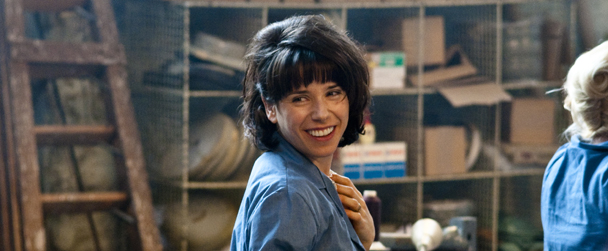Made in Dagenham
The pride with which it was made is clear to see, for British cinema and for a hundred and eighty seven of Dagenham’s finest.
Plot summary
Rita O’Grady is a feisty yet warm-hearted worker at the Ford car plant in Dagenham who leads the girls in a revolution for equal pay for women.

When Made In Dagenham comes to a close there is a welcome postscript as the credits roll. I won’t give it away, but the sequence is a droll reminder of the concessions made when real events are rendered for the silver screen. It’s also a well exploited opportunity for the filmmakers to boast, “Look, we nailed it.” And they just about did.
No time is wasted in getting to the crucial flashpoint that sets things in motion: The women of the Ford plant in Dagenham have been downgraded in status from semi-skilled to unskilled workers. In a factory of tens of thousands of men, these one hundred and eighty seven women are an easy target for cuts and face their meagre pay being further reduced. Ford management in the US have decided that the women won’t make a fuss. And if they do make a fuss, they certainly won’t strike. And if they do strike, they certainly won’t make much noise. Made in Dagenham shows how a bunch of spirited East-enders proved them wrong.
Sally Hawkins as the leader of strike action, Rita O’Grady, is the stand out performer in a great cast full of strong female characters. For my money, her performance is less mannered and more rounded, memorable, and luminous than her breakthrough role in Happy Go Lucky. Countless scenes in the factory, at Ford headquarters, at union meetings, and in parliament run from bracing and formidable to fragile and withdrawn. And she’s a brilliant comedian. Daniel Mays’ Eddie O’Grady also deserves special mention, he is movingly brittle in trying to survive the shift in his relationship with Rita and her burgeoning fame. Andrea Riseborough meanwhile relishes the role of Brenda and Miranda Richardson, Geraldine James, Rosamund Pike and Jaime Winston are all excellent in several well developed sub-plots that add texture and personality to life in the midst of Ford’s sewing machines.
Amongst the men, only Bob Hoskins as union shop steward Bob Hoskins (or ‘Albert’ if you like) escapes from being shown in some way as either flawed or slightly enfeebled. The husbands and boyfriends in the factory are depicted as supportive but emasculated, union bosses as arrogant and compromised, Westminster mandarins as wet and ineffectual, factory bosses as chauvinistic and detached. It’s a biting portrayal of an unjust patriarchal society whereas, in their variety and flawed humanity, the women are roundly resilient and courageous. Yes, it’s simplified, but it tells a story of real life goodies and baddies with just enough authenticity.
While emotional buttons are mostly pressed in bigger, rowdier scenes, Rita and Lisa, the educated, put upon wife of a Ford executive, have the privilege of the film’s singular moment of low-key poignancy. When Lisa makes an unannounced visit to Rita’s flat she reveals her misery in the domestic, subservient life she has stumbled into and looks back with longing for the vitality of her student days. She describes her passion for history and her naive fantasies of a life in the mould of the women celebrated in her books. Lisa asks if, when the fight is over and the cause won, Rita might tell her what it feels like to make history. Cloying as this sounds, the scene works. It points to the uncomplicated drive of the film to try and say: It feels like this.
It might seem a quandary that the final destination is a matter of public record: the underdog comes good; David beats Goliath. This is overcome with aplomb as the script proves the old cliché that it’s the getting there that counts. A nice line in the doubling of characters and situations and an abundance of stirring and evocative detail make it an absorbing yarn. Various sub-plots skilfully flesh out the landscape of 1960s gender politics and a wide cast of supporting parts and cameos are so well drawn and performed that without being overpopulated their world feels alive, busy and real.
Though it’s a work of unashamed mainstream sensibilities the only element that really grates is when pivotal moments are labelled with an emotive score. It’s a lone duff note, both patronising and unnecessary. In spite of that, the plight of the workers is handled without condescension and the era is conjured with telling personal touches that complement the excellent production design. Terrific acting aside, its main asset is a script that offers a rock-solid lesson in structure.
If the ladies whose story this is hope to recognise themselves in the photogenic charms of Sandra or Brenda, they might be disappointed. Or if these celebrated Londoners are suckers for historical veracity, they will probably find their tale loosely told. The fact is that this portrait of a famous chapter in their lives is painted in sure but simple strokes. Yet, an expert confidence in the telling makes for properly involving cinema. It is warming, exciting, energising and truly uplifting. If you see an unsmiling face leaving a screening then you have found yourself a genuine curmudgeon. Anyone else will have their hearts lifted and their cockles warmed. The pride with which it was made is clear to see, for British cinema and for a hundred and eighty seven of Dagenham’s finest.











COMMENTS